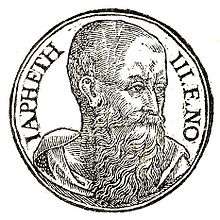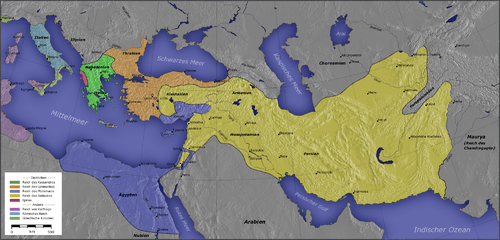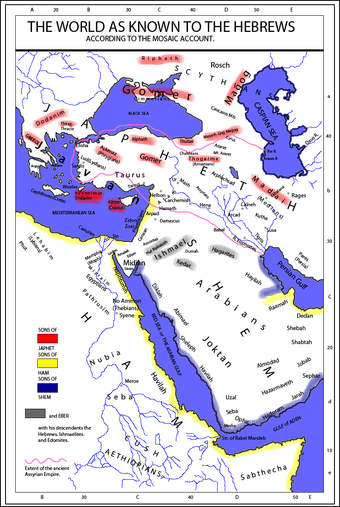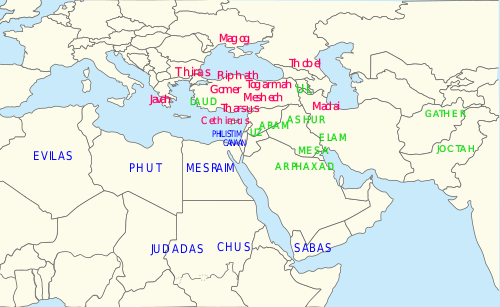Japheth
Japheth /ˈdʒeɪfɛθ/ (Hebrew: יֶפֶת Yép̄eṯ, in pausa יָפֶת Yā́p̄eṯ; Greek: Ἰάφεθ Iápheth; Latin: Iafeth, Iapheth, Iaphethus, Iapetus), is one of the three sons of Noah in the Book of Genesis, in which he plays a role in the story of Noah's drunkenness and the curse of Ham, and subsequently in the Table of Nations as the ancestor of the peoples of the Aegean Sea, Anatolia, and elsewhere.[1] In medieval and early modern European tradition he was considered to be the progenitor of European and, later, East Asian peoples.[2][3][4]
Japhet (Biblical character) | |
|---|---|
 "Japhet third son of Noah", as depicted in Promptuarii Iconum Insigniorum (c. 1553) | |
| Children | Gomer Magog Madai Javan Tubal Meshech Tiras |
| Parent(s) | Noah |
Etymology
The meaning of the name Japheth is disputable. There are two possible sources to the meaning of the name:[5]
- From Aramaic root פתה, meaning to extend. In this case, the name would mean may He extend (Rashi).
- From Hebrew root יפה, meaning beauty, in which case the name would mean beautiful.
Japheth in the Book of Genesis
Japheth first appears in the Book of Genesis as one of the three sons of Noah, saved from the flood through the Ark. In the bible, they are always in the order "Shem, Ham, and Japheth" when all three are listed (Genesis 5:32, 9:18 and 10:1).[6] However Genesis 9:24 calls Ham the youngest,[6] and Genesis 10:21 refers ambiguously to Shem as "brother of Japheth the elder," which could mean that either is the eldest.[7] Most modern writers accept Shem-Ham-Japheth as reflecting birth order, but this is not always the case: Moses and Rachel also appear at the head of such lists despite explicit descriptions of them as younger siblings.[8]

Following the Flood Japheth is featured in the story of Noah's drunkenness. Ham sees Noah drunk and naked in his tent and tells his brothers, who then cover their father with a cloak while avoiding the sight; when Noah awakes he curses Canaan, the son of Ham, and blesses Shem and Japheth: "Blessed be the Lord God of Shem and may Canaan be his slave; and may God enlarge Japheth and may he dwell in the tents of Shem, and may Canaan be his slave!” (Genesis 9:20-27).
Chapter 10 of Genesis, the Table of Nations, describes how the entire Earth was populated by the sons of Noah following the Flood, beginning with the descendants of Japheth:
| Japheth | |||||||||||||||||||||||||||||||||||||||||||||||||||||||||
| Gomer | Magog | Madai | Javan | Tubal | Meshech | Tiras | |||||||||||||||||||||||||||||||||||||||||||||||||||
| Ashkenaz | Riphath | Togarmah | Elishah | Tarshish | Kittim | Dodanim | |||||||||||||||||||||||||||||||||||||||||||||||||||
Origin of Japheth
The Book of Genesis is the first of the five books of the Torah, that contains the account of Israel's origins as a people. Scholars increasingly see this as a product of the Achaemenid Empire (probably 450-350 BCE), although some would place its production in the Hellenistic period (333-164 BCE) or even the Hasmonean dynasty (140–37 BCE).[9] As almost none of the persons, places and stories in the first eleven chapters of Genesis (called the primeval history) are ever mentioned anywhere else in the Bible, leading scholars to surmise that the story of Japheth and his brothers is a late composition, attached to Genesis to serve as an introduction to that book and to the Torah.[10][11]

Japheth (in Hebrew, Yafet or Yefet) may be a transliteration of the Greek Iapetos, the ancestor of the Hellenic peoples.[12][13] His sons and grandsons associate him with the geographic area of the eastern Mediterranean and Asia — Ionia/Javan, Rhodes/Rodanim, Cyprus/Kittim, and other points in the region of Greece and Asia Minor — approximating to one of the kingdoms (Lysimachus) into which the generals of Alexander the Great divided his empire on his death (the descendants of Shem and Ham respectively correspond to the other two, those of the Ptolemies and Seleucids).[13][14] The point of the "blessing of Japheth" seems to be that Japheth (a Greek-descended people) and Shem (the Israelites) would rule jointly over Canaan (Palestine). From the 19th century until the late 20th century it was usual to see Japheth as a reference to the Philistines, who shared dominion over Canaan during the pre-monarchic and early monarchic period of Israel's history.[15] This view accorded with earlier understanding of the origin of the Book of Genesis, which was seen as having been composed in stages beginning with the time of Solomon, when the Philistines still existed (they vanish from history after the Babylonian conquest of Canaan). However, Genesis 10:14 identifies their ancestor as Ham rather than Japheth.[12]
Place in Noah's family

For those who take the genealogies of Genesis to be historically accurate, Japheth is commonly believed to be the father of Europeans. The link between Japheth and the Europeans stems from Genesis 10:5, which states:
"By these were the isles of the Gentiles divided in their lands."
According to that book, Japheth and his two brothers formed the three major races:
- Japheth is the father of the Japhetic race
- Shem is the father of the Semitic race
- Ham is the father of the Hamitic race
William Shakespeare's play Henry IV, Part II contains a wry comment about people who claim to be related to royal families. Prince Hal notes of such people,
...they will be kin to us, or they will fetch it from Japhet. (II.ii 117-18)
Descendants

In the Bible, Japheth is ascribed seven sons: Gomer, Magog, Tiras, Javan, Meshech, Tubal, and Madai. According to Josephus (Antiquities of the Jews I.6):
Japhet, the son of Noah, had seven sons: they inhabited so, that, beginning at the mountains Taurus and Amanus, they proceeded along Asia, as far as the river Tanais (Don), and along Europe to Cadiz; and settling themselves on the lands which they light upon, which none had inhabited before, they called the nations by their own names.
Josephus subsequently detailed the nations supposed to have descended from the seven sons of Japheth.
The "Book of Jasher", published by Talmudic rabbis in the 17th century, provides some new names for Japheth's grandchildren not found in the Bible, and provided a much more detailed genealogy (see Japhetic).
Europeans
In the seventh century, Isidore of Seville published his noted history, in which he traces the origins of most of the nations of Europe back to Japheth.[16][17] Scholars in almost every European nation continued to repeat and develop Saint Isidore's assertion of descent from Noah through Japheth into the nineteenth century.[4]
Ivane Javakhishvili associated Japheth's sons with certain ancient tribes, called Tubals (Tabals, Greek: Tibarenoi) and Meshechs (Meshekhs/Mosokhs, Greek: Moschoi), who they claim represent non-Indo-European and non-Semitic, possibly "Proto-Iberian" tribes of Asia Minor of the 3rd-1st millennia BC.[3]
In the Polish tradition of Sarmatism, the Sarmatians, an Iranic people, were said to be descended from Japheth, son of Noah, enabling the Polish nobility to imagine that their ancestry could be traced directly to Noah.[4]
In Scotland, histories tracing the Scottish people to Japheth were published as late as George Chalmers' well-received Caledonia, published in 3 volumes from 1807 to 1824.[18]
In Islamic tradition
Japheth is not mentioned by name in the Qur'an but is referred to indirectly in the narrative of Noah (7:64, 10:73, 11:40, 23:27, 26:119). Muslim exegesis, however, names all of Noah's sons, and these include Japheth.[19] In identifying Japheth's descendants, Muslim exegesis mostly agrees with the Biblical traditions.[20] He is usually regarded as the ancestor of the Gog and Magog tribes, and, at times, of the Turks, Khazars, and Slavs. Some traditions narrated that 36 languages of the world could be traced back to Japheth.[21]
See also
- Caucasian race
- Japhetic
- Japhetic theory (linguistics)
- Indo-European languages
- Mongoloid race
- Proto-Indo-Europeans
- Sons of Noah
- Whites
- Wives aboard the Ark
References
Citations
- Hunt 1990, p. 430.
- Susan Reynolds, "Medieval origines gentium and the community of the realm," History, 68, 1983, pp. 375-90
- Ivane Javakhishvili. "Historical-Ethnological problems of Georgia, the Caucasus and the Near East" (a monograph), Tbilisi, 1950, pp. 130–135 (in Georgian)
- Colin Kidd, British Identities before Nationalism; Ethnicity and Nationhood in the Atlantic World, 1600-1800, Cambridge University Press, 1999, p. 29
- "Japheth". Jewish Encyclopedia (1906). Retrieved 2017-07-21.
- Haynes 2002, p. 204,269.
- Garcia Martinez 2012, p. 33 fn.7.
- Greenspahn 1994, p. 65.
- Greifenhagen 2003, p. 206-207, 224 fn.49.
- Blenkinsopp 2011, p. 2.
- Sailhamer 2010, p. 301.
- Day 2014, p. 39.
- Glouberman 2012, p. 112.
- Gmirkin 2006, p. 165 fn.192.
- Day 2014, p. 38-39.
- Leyser, Karl (1994). Communications and Power in Medieval Europe: The Carolingian and Ottonian Centuries. A&C Black. p. 5. ISBN 9781852850135. Retrieved 10 August 2019.
Already in Isidore of Seville they were the founders of towns and regions in Europe, Asia and Africa.14 The whole human race must be descended from them and they, Shem, Ham and Japheth therefore divided the world between them. Europe was Japheth’s share, and his numerous offspring and their descendants in turn were the ancestors of all the greater European peoples: Franks, Latins, Alemans and Britains, to name but some.
- Richard Cole (2015). "Proto-Racial Thinking and its Application to Jews in Old Norse Literature". In Heß, Cordelia; Adams, Jonathan (eds.). Fear and Loathing in the North: Jews and Muslims in Medieval Scandinavia and the Baltic Region. Walter de Gruyter GmbH & Co KG. p. 258. ISBN 9783110346473.
- Colin Kidd, British Identities before Nationalism; Ethnicity and Nationhood in the Atlantic World, 1600-1800, Cambridge University Press, 1999, p. 52
- Tabari, Volume I: Prophets and Patriarchs, 222
- Tabari, Volume I: Prophets and Patriarchs, 217
- Encyclopedia of Islam, Yafith, 236
Bibliography
- Bremmer, Jan N. (2004). "Remember the Titans!". In Auffarth, Christoph; Stuckenbruck, Loren T. (eds.). The Fall of the Angels. BRILL. ISBN 9004126686.CS1 maint: ref=harv (link)
- Day, John (2014). "Noah's Drunkenness, the Curse of Canaan". In Baer, David A.; Gordon, Robert P. (eds.). Leshon Limmudim: Essays on the Language and Literature of the Hebrew Bible in Honour of A.A. Macintosh. A&C Black. ISBN 9780567308238.CS1 maint: ref=harv (link)
- Garcia Martinez, Florentino (2012). Between Philology and Theology: Contributions to the Study of Ancient Jewish Interpretation. BRILL. ISBN 9004243933.CS1 maint: ref=harv (link)
- Glouberman, Mark (2012). The Raven, the Dove, and the Owl of Minerva: The Creation of Humankind in Athens and Jerusalem. University of Toronto Press. ISBN 9781442645059.CS1 maint: ref=harv (link)
- Gmirkin, Russell (2006). Berossus and Genesis, Manetho and Exodus: Hellenistic Histories and the Date of the Pentateuch. Bloomsbury. ISBN 9780567134394.CS1 maint: ref=harv (link)
- Greenspahn, Frederick E. (1994). When Brothers Dwell Together: The Preeminence of Younger Siblings in the Hebrew Bible. Oxford University Press. ISBN 9780195359558.CS1 maint: ref=harv (link)
- Greifenhagen, Franz V. (2003). Egypt on the Pentateuch's Ideological Map. Bloomsbury. ISBN 9780567391360.CS1 maint: ref=harv (link)
- Haynes, Stephen R. (2002). Noah's Curse: The Biblical Justification of American Slavery. Oxford University Press. ISBN 9780198032601.CS1 maint: ref=harv (link)
- Hunt, Harry B., Jr. (1990). "Japheth". In Mills, Watson E.; Bullard, Roger Aubrey (eds.). Mercer Dictionary of the Bible. Mercer University Press. ISBN 9780865543737.CS1 maint: ref=harv (link)
- Kvanvig, Helge (2011). Primeval History: Babylonian, Biblical, and Enochic: An Intertextual Reading. BRILL. ISBN 9004163808.CS1 maint: ref=harv (link)
- Thompson, Thomas L.; Wajdenbaum, Philippe (2014). "Making Room for Japheth". In Thompson, Thomas L.; Wajdenbaum, Philippe (eds.). The Bible and Hellenism: Greek Influence on Jewish and Early Christian Literature. Routledge. ISBN 9781317544265.CS1 maint: ref=harv (link)
- Wajbenbaum, Philippe (2016). "Genesis-Kings as a Platonic Epic". In Hjelm, Ingrid; Thompson, Thomas L. (eds.). Biblical Interpretation Beyond Historicity. Routledge.CS1 maint: ref=harv (link)
External links
| Wikimedia Commons has media related to Japheth. |
- . Encyclopædia Britannica. 15 (11th ed.). 1911.
- Easton Bible dictionary about Japheth
- Smith's Bible Dictionary about Japheth
- International Standard Bible Encyclopedia: Japheth
- Japheth in the Jewish Encyclopedia
- Japheth's family tree at complete-bible-genealogy.com